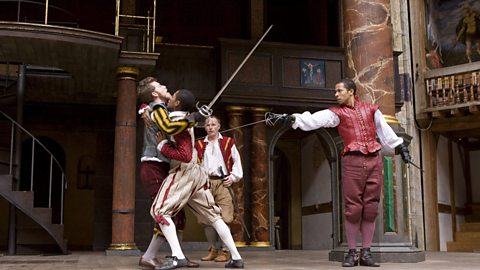Conflict in Romeo and Juliet

Conflict is a central theme in Shakespeare's Romeo and Juliet. Shakespeare presents the theme of conflict through two warring families: the Montagues and the Capulets. The two families have been taught to hate each other, and this hatred impacts on the family members and the citizens of Verona. The citizens of Verona are unwillingly a part of the conflict as they witness the ongoing battles between the two families - battles which often result in death.
Shakespeare also presents the themes of conflict through inner familial conflict and individual conflict. Where conflict is presented, the struggle for power and control is also apparent.
How is the theme of conflict shown in Romeo and Juliet?
Conflict is shown in Romeo and Juliet through:
- the two warring families: Montagues and the Capulets
- Juliet's inner conflict when she discovers Romeo is a Montague
- conflict between Tybalt and Romeo
- conflict between Juliet and her father
| How does Shakespeare show this? | Evidence | Analysis | |
| The two warring families | Shakespeare opens the play with a prologue and it is here that he first depicts the conflict between the Montagues and the Capulets. | "Two households, both alike in dignity, in fair Verona, where we lay our scene, from ancient grudge break to new mutiny, where civil blood makes civil hands unclean." | Shakespeare opens his play with the first line, illustrating the "ancient" grudge that has been happening in Verona. Shakespeare does this to show that the conflict has been ongoing and isn't likely to stop. He describes it as "ancient"' to illustrate how ingrained the conflict is with the families - it is a part of their daily lives. |
| Juliet's inner conflict | When Juliet discovers the true identity of her true love, she is shocked and cannot believe she loves someone who she is supposed to hate. | "That I must love a loathed enemy." | Juliet uses 'must' which indicates that she has no other choice - she loves Romeo and cannot change the fact. This presents a conflict for Juliet, as she cannot change what she feels - despite knowing that she should. |
| Conflict between Tybalt and Romeo | Tybalt believes Romeo to have greatly dishonoured his family when he gate-crashes the Capulet party. He decides that Romeo must pay and offers to duel with Romeo. | "Boy, this shall not excuse the injuries that thou hast done me; therefore turn and draw." | This shows that Tybalt believes he has been injured with Romeo's actions. He commands Romeo to 'turn and draw', taking part in a fight. |
| The two warring families | |
|---|---|
| How does Shakespeare show this? | Shakespeare opens the play with a prologue and it is here that he first depicts the conflict between the Montagues and the Capulets. |
| Evidence | "Two households, both alike in dignity, in fair Verona, where we lay our scene, from ancient grudge break to new mutiny, where civil blood makes civil hands unclean." |
| Analysis | Shakespeare opens his play with the first line, illustrating the "ancient" grudge that has been happening in Verona. Shakespeare does this to show that the conflict has been ongoing and isn't likely to stop. He describes it as "ancient"' to illustrate how ingrained the conflict is with the families - it is a part of their daily lives. |
| Juliet's inner conflict | |
|---|---|
| How does Shakespeare show this? | When Juliet discovers the true identity of her true love, she is shocked and cannot believe she loves someone who she is supposed to hate. |
| Evidence | "That I must love a loathed enemy." |
| Analysis | Juliet uses 'must' which indicates that she has no other choice - she loves Romeo and cannot change the fact. This presents a conflict for Juliet, as she cannot change what she feels - despite knowing that she should. |
| Conflict between Tybalt and Romeo | |
|---|---|
| How does Shakespeare show this? | Tybalt believes Romeo to have greatly dishonoured his family when he gate-crashes the Capulet party. He decides that Romeo must pay and offers to duel with Romeo. |
| Evidence | "Boy, this shall not excuse the injuries that thou hast done me; therefore turn and draw." |
| Analysis | This shows that Tybalt believes he has been injured with Romeo's actions. He commands Romeo to 'turn and draw', taking part in a fight. |
Question
Why has Shakespeare used the theme of conflict in this play?
- Audience members can relate to the theme, as they will have all been a part of conflict in their lives.
- Conflict is the reason why the play is tragic: it is because of the families' conflict that Romeo and Juliet die.
Learn more about the theme of conflict in Romeo and Juliet by listening to this podcast.
Listen to the full series on ≥…»ÀøÏ ÷ Sounds.
Hollie and Testament discuss the theme of conflict in Shakespeare’s play, Romeo and Juliet